



 |    |
The Multi-Core battle - Core 2 results (November 2006)
Slow emulation is not fun, yet most emulation software (and Windows software in general) tends to be painfully slow. This is due to poor programming practices such as misuse of DLLs (also known as "DLL Hell"), the use of C++ or other inefficient compiled languages, not re-optimizing code to take advantage of the latest microprocessor and operating system features, and other common mistakes made by programmers.
Not here. All Emulators products are designed to be fast and efficient. Every product we offer for the PC designed to run on a minimal Pentium based computer with 32 megabytes of RAM running at 75 MHz and running Windows 98. Even though most of our products will even run on older 486 based PCs with even less memory, chances are that your PC already exceeds these design goals. If your PC can run Windows 98, it can run our software.
Our products are written almost entirely in hand optimized assembly language for maximum speed and for minimum size on disk and in memory. Each of our products take up less than 1 megabyte of disk space and can still be run from floppy disk or directly from the distribution CD-ROM, making it trivial for you to transfer our software from machine to machine as needed. No complex installation procedures required.
The chart below gives general guidelines on the minimum and recommended configurations for each of our products on various DOS and Windows platforms. These numbers take into account the memory and disk space necessary for the installation of Windows itself plus the typical installation of a Macintosh emulator running Mac OS 8. The benchmarks which follow will give you a rough idea of how fast your emulated Macintosh software will run on various PC platforms. You can read more tips about buying, upgrading, and optimizing a PC on our Secrets page.
| MS-DOS 6 | Windows 95 and OSR2 | Windows NT 4.0 | Windows 98 and Second Edition | Windows 2000 | Windows Millennium | Windows XP | |
|---|---|---|---|---|---|---|---|
| Minimum processor speed | 33 MHz | 33 MHz | 33 MHz | 66 MHz | 166 MHz | 166 MHz | 233 MHz |
| Recommended processor speed | 75+ MHz | 75+ MHz | 75+ MHz | 166+ MHz | 233+ MHz | 233+ MHz | 500+ MHz |
| Minimum RAM | 8 MB | 16 MB | 24 MB | 32 MB | 64 MB | 64 MB | 128 MB |
| Recommended RAM | 32 MB | 64 MB | 64 MB | 64 MB | 128 MB | 128 MB | 256 MB |
| Minimum hard disk size | 500 MB | 1 GB | 1 GB | 1 GB | 2 GB | 2 GB | 4 GB |
| Supports Gemulator Explorer? | No | Yes | Yes | Yes | Yes | Yes | Yes |
| Supports Gemulator 2000? | No | Yes | Yes | Yes | Yes | Yes | Yes |
| Supports Gemulator Professional? | No | No | No | Yes | Yes | Yes | Yes |
| Supports SoftMac 2000? | No | Yes | Yes | Yes | Yes | Yes | Yes |
| Supports SoftMac Classic? | No | Yes | Yes | Yes | Yes | Yes | Yes |
| Supports SoftMac Xpress? | No | No | No | Yes | Yes | Yes | Yes |
| Supports SoftMac Professional? | No | No | No | No | No | No | Yes |
| Supports Fusion PC? | Yes | Yes | No | Yes | No | No | No |
Since 1997, when our first Windows based Macintosh emulator was released, we began timing Macintosh emulation using a typical Word 5.1 word count scenario. Measuring speed like this is also know as benchmarking. While the real 68000 and 68040 based Macintosh computers required anywhere from about 20 seconds to 4 minutes to complete the benchmark, the time is reduced dramatically when those same Macs are emulated on a PC using our emulation software.
We chose this benchmark for two reasons. First, it is computationally intensive, which is a good test of raw emulation speed. Using a medium sized Word document (specifically, one of our older Xformer user manuals) we have Word 5.1 count the characters, words, lines, and paragraphs in the document. The faster the computer (or emulator), the quicker the word count completes. Secondly, we chose Word 5.1 specifically because it is a popular release of Word for the classic Macintosh that runs on almost all models of Macintosh computers - from the most basic Macintosh Plus and up - and this is a good indicator of what we call real world performance. That is, how fast something that people really do runs, which is what ultimately really matters. Without fast speed, and emulator is useless.
Starting in November 2000 we expanded our Macintosh benchmarks considerably to include a wider number of benchmarks. This was done as part of our in-depth testing of the Pentium 4 and is now used to test all other new processors. We added 5 additional applications to the test, resulting in a total of 22 different benchmark results. The Macintosh applications used for the benchmarks are:
Word 5.1, by Microsoft
Apple Personal Diagnostics 1.1.3, Apple's own diagnostic and benchmark utility
Adobe Photoshop 3.0, used to load a sample 2.2M JPG document
Speedometer 3.23 by Scott Berfield, a commonly used Mac benchmark utility
Floating Fractals 5.0 by Adam Smith, a floating point intensive fractal generator
Power Demo 5 by DayStar Digital, the default DayStars demo
Click on these thumbnails for sample screen shots of these applications.
These benchmarks combined represent an assortment of integer, memory, floating point, and video related tests. Each benchmark is either timed with a stopwatch, prints out a time in seconds, or prints out a ratio relative to a base Macintosh system. In the results below, all numbers are either in seconds (smaller means faster) or are expressed as a ratio (larger means faster).
Two sets of benchmarks are presented.
The first set of benchmarks below is the SoftMac 2000 version 8.02 test, using the SoftMac 8.02 emulator which was posted to our web site on January 1 2001 (and is possibly one of the first software releases of the 21st century). These benchmarks were originally conducted between December 2000 and March 2001 and posted here in March 2001, with some additional tests added since for newer processors as listed.
For consistency, all computers were running the same release of SoftMac 8.02 in full screen mode, using the same Quadra 650 ROMs, the same installation of Mac OS 8.1, 24 megabytes of Macintosh memory, and 512K of Mac OS disk cache. All machines were equipped with at least 128 megabytes of RAM (more than necessary), typically set up with 40 or 60 gigabyte hard disks, and mostly running Windows Millennium Edition (the currently shipping release of Windows as of March 2001).
| SoftMac 2000 v. 8.02 Benchmarks | Celeron 533 MHz Win Me 128M | Pentium III 650 MHz XP Beta 1 288M | Pentium III 670 MHz Win 2000 1024M | Pentium III Xeon 1.0 GHz Win 2000 512M | AMD Athlon 900 MHz Win Me 256M | AMD Athlon 1.2 GHz Win Me 512M | Pentium 4 1.5 GHz Win Me 512M | Pentium III 256K L2 1.2 GHz Win Me 512M | AMD Athlon XP 1800 1.53 GHz Win Me 512M | Pentium 4 256K L2 2.0 GHz Win XP 256M | Pentium 4 512K L2 2.2 GHz Win Me 512M |
| Word 5.1 Word Count (rounded to nearest second) | 12 s | 7 s | 7 s | 5 s | 6 s | 4 s | 6 s | 4 s | 3 s | 4 s | 4 s |
| Photoshop Load 2.2M JPG file (rounded to nearest second) | 53 s | 40 s | 37 s | 27 s | 26 s | 19 s | 23 s | 19 s | 17 s | 19 s | 18 s |
| Floating Fractals 1000 iteration rendering (displayed time in seconds) | 58.07 s | 47.45 s | 46.35 s | 31.27 s | 37.0 s | 27.37 s | 82.0 s | 26.4 s | 23.0 s | 26.4 s | 53.0 s |
| Power Demo DayStars demo, default settings (displayed time in seconds) | 4.35 s | 2.55 s | 2.52 s | 1.72 s | 2.00 s | 1.48 s | 2.37 s | 1.43 s | 1.18 s | 1.43 s | 1.48 s |
| Apple Personal Diagnostics Tests | |||||||||||
| Integer | 111.5 | 136.1 | 143.8 | 207.0 | 187.9 | 232.1 | 236.3 | 252.0 | 317.8 | 252.0 | 308.0 |
| Complex Funcs | 444.1 | 573.3 | 640.5 | 841.8 | 781.0 | 1050.0 | 527.0 | 1049.0 | 1327.0 | 1049.0 | 845.4 |
| Floating Point | 258.0 | 310.4 | 353.0 | 483.7 | 405.3 | 550.1 | 388.2 | 579.3 | 697.4 | 579.3 | 585.6 |
| Memory | 110.6 | 135.8 | 152.0 | 207.8 | 174.3 | 214.6 | 299.4 | 251.2 | 298.5 | 251.2 | 445.2 |
| Processor | 41.0 | 50.4 | 56.5 | 77.1 | 69.5 | 84.8 | 96.0 | 92.9 | 118.0 | 92.9 | 142.9 |
| Video | 11.9 | 22.7 | 25.1 | 35.9 | 35.13 | 45.0 | 30.2 | 43.9 | 58.5 | 43.9 | 51.9 |
| Speedometer Tests | |||||||||||
| CPU | 82.3 | 108.1 | 101.8 | 144.2 | 101.8 | 133.1 | 173.0 | 192.2 | 173.0 | 192.2 | 247.0 |
| Graphics | 30.5 | 47.6 | 47.6 | 68.9 | 61.5 | 81.5 | 62.4 | 81.5 | 99.9 | 81.5 | 92.9 |
| Disk | 34.8 | 34.0 | 46.4 | 63.8 | 80.6 | 109.3 | 109.3 | 102.1 | 139.8 | 102.1 | 191.4 |
| Math | 231.6 | 293.6 | 295.0 | 440.0 | 359.5 | 487.0 | 346.4 | 536.7 | 615.4 | 536.7 | 567.7 |
| FPU KWhetstones | 10000 | 12000 | 15000 | 20000 | 15000 | 20000 | 12000 | 20000 | 30000 | 20000 | 20000 |
| FPU Matrix Multiply (seconds) | .667 s | .533 s | .533 s | .350 s | .417 s | .300 s | .467 s | .300 s | .233 s | .300 s | .300 s |
| FPU FFT (seconds) | .300 s | .233 s | .233 s | .150 s | .183 s | .133 s | .233 s | .133 s | .100 s | .133 s | .150 s |
| FPU Average | 11.23 | 13.9 | 15.3 | 22.1 | 17.6 | 24.0 | 14.7 | 24.0 | 33.2 | 24.0 | 23.2 |
| Mix KWhetstones | 2608 | 3333 | 3333 | 5000 | 4285 | 5454 | 3333 | 6000 | 6666 | 6000 | 5000 |
| Mix Dhrystones | 38961 | 54545 | 55555 | 81081 | 66666 | 88235 | 73170 | 96774 | 111111 | 96774 | 111111 |
| Mix Average | 102.5 | 130.7 | 132.0 | 198.0 | 167.4 | 221.6 | 174.1 | 236.3 | 278.4 | 236.3 | 262.8 |
| Video Average | 11.0 | 20.28 | 19.9 | 30.28 | 27.27 | 36.5 | 27.8 | 36.7 | 46.2 | 36.7 | 44.1 |
The specifics of the SoftMac 8.02 testing systems are as follows:
Celeron 533 - a generic 533 MHz Celeron with 66 MHz FSB, 128M of PC100 memory, Windows Millennium
Pentium III 650 - a Gateway Solo 650 MHz notebook with 288M of memory, Windows XP "Whistler" beta 1
Pentium III 670 - a generic dual processor Pentium III running in single processor mode, 1G of PC100 memory, Windows 2000
Pentium III Xeon - a dual processor 1.0 GHz Dell workstation running in single processor mode, 512M of PC800 RDRAM, Windows 2000
Athlon 900 - a generic 900 MHz Athlon upgraded from PC133 to 256M of PC2100 DDR memory, Windows Millennium
Athlon 1.2 - an XI Computer 1.2 GHz Athlon, 512M of PC2100 DDR memory, Windows Millennium
Pentium 4 1.5 - a Gateway 1500xl 1.5 GHz Pentium 4, 512M of PC800 RDRAM memory, Windows Millennium
Pentium III - a generic 1.2 GHz Pentium III-M Tualatin, 512M of PC133 SDRAM, Windows Millennium (added October 2001)
Athlon XP - a generic 1.53 GHz Athlon XP 1800, 512M of PC2100 DDR memory, Windows Millennium (added October 2001)
Pentium 4 2.0 - a generic 2.0 GHz Pentium 4 (Socket 423, 256K L2 cache), 256M of PC800 RDRAM memory, Windows XP Home (added April 2002)
Pentium 4 2.2 - a generic 2.2 GHz Pentium 4 (Socket 478, 512K L2 cache), 512M of PC2700 DDR memory, Windows Millennium (added April 2002)
Macintosh Emulation Benchmarks (Windows XP and SoftMac XP)
The second set of benchmarks below are the most recent tests conducted using our SoftMac XP 8.20 Xpress Edition product released in April 2002. The SoftMac Xpress product is specifically optimized for Windows XP and for high bandwidth memory (such as DDR and RDRAM) found in today's mainstream PCs. As you can see, the combination of switching from Windows Millennium to Windows XP, and switching from SoftMac 2000 to SoftMac Xpress greatly speeds up some of the benchmark results and in general delivers a speed win on all gigahertz-class processors.
As before, we maintained consistency by running the same release of SoftMac Xpress 8.20 in full screen mode, using the same Quadra 650 ROMs, the same installation of Mac OS 8.1, 24 megabytes of Macintosh memory, and 512K of Mac OS disk cache as in the March 2001 tests. We also used the same benchmark programs as in the earlier tests. All machines were equipped with at least 512 megabytes of RAM (more than necessary), 40 to 80 gigabyte hard disks, and most running Windows XP Professional Edition with all the current Windows Update patches applied.
These results are broken up into two tables to fit better on the screen. This first table compares of older single-core processor systems in single- and dual-processor configurations. In this set of machines, the Pentium M based "Centrino" based notebooks score the best efficiency at a given clock speed, even outperforming AMD Athlon and Intel Pentium 4 desktop systems.
| SoftMac XP v. 8.20 Benchmarks (single-core) | Pentium III 256K L2 670 MHz Win 2000 1024M | Pentium III 256K L2 700 MHz Win XP 256M | Pentium 4 256K L2 1.5 GHz Win XP 512M | Pentium III 512K L2 1.2 GHz Win XP 512M | Pentium M 2M L2 1.1 GHz Win XP 512M | Pentium III 512K L2 1.53 GHz Win XP 512M | AMD Athlon XP 1900 1.6 GHz Win XP 512M | AMD Athlon XP 2200 1.8 GHz Win XP 512M | Pentium M 1M L2 1.6 GHz Win XP 512M | AMD Opteron 1M L2 1.6 GHz Win XP 1024M | AMD Athlon64 512K L2 2.0 GHz Win XP 1024M | Xeon HT 512K L2 2.0 GHz Win XP 1024M | Pentium 4 512K L2 2.2 GHz Win XP 512M | Pentium 4 512K L2 2.6 GHz Win XP 512M |
| Word 5.1 Word Count (rounded to nearest second) | 7 s | 7 s | 6 s | 4 s | 4 s | 3 s | 3 s | ? | 2 s | 3 s | 2 s | 4 s | 3 s | 3 s |
| Photoshop Load 2.2M JPG file (rounded to nearest second) | 29 s | ? s | 21 s | 17 s | 13 s | 13 s | 14 s | ? | 9 s | 13 s | 10 s | ? s | 14 s | 12 s |
| Floating Fractals 100 iteration rendering (displayed time in seconds) | 5.35 s | 5.20 s | 3.17 s | 3.03 s | 6.00 s | 2.32 s | 2.32 s | 2.08 s | 2.00 s | 2.22 s | 2.00 s | 2.50 s | 2.15 s | 2.00 s |
| Power Demo DayStars demo, default settings (displayed time in seconds) | 2.33 s | 2.30 s | 1.67 s | 1.33 s | 1.22 s | 0.98 s | 1.02 s | 0.92 s | 0.77 s | 1.02 s | 0.80 s | 1.18 s | 1.03 s | 0.88 s |
| Apple Personal Diagnostics Tests | ||||||||||||||
| Integer | 142 | 150 | 220 | 254 | 365 | 328 | 324 | 357 | 512 | 338 | 393 | 292 | 302 | 409 |
| Complex Funcs | 677 | 709 | 1104 | 1208 | 1198 | 1560 | 1632 | 1820 | 2116 | 1724 | 2166 | 1518 | 1696 | 2021 |
| Floating Point | 354 | 385 | 564 | 614 | 638 | 792 | 789 | 874 | 1064 | 816 | 1013 | 745 | 865 | 1020 |
| Memory | 160 | 181 | 280 | 278 | 269 | 360 | 289 | 324 | 379 | 281 | 348 | 378 | 458 | 497 |
| Processor | 94 | 93 | 113 | 166 | 168 | 216 | 201 | 225 | 242 | 228 | 285 | 170 | 173 | 207 |
| Video | 25.5 | 26.0 | 35.3 | 45.7 | 51.7 | 65.4 | 60 | 68.4 | 86.9 | 60.5 | 78.2 | 50.5 | 58.8 | 68 |
| Speedometer Tests | ||||||||||||||
| CPU | 115 | 115 | 173 | 192 | 173 | 247 | 192 | 216 | 288 | 192 | 247 | 247 | 288 | 346 |
| Graphics | 48 | 53 | 69 | 81 | 93 | 100 | 105 | 104 | 133 | 95 | 121 | 93 | 102 | 108 |
| Disk | 54 | 56 | 90 | 90 | 96 | 127 | 63 | 127 | 218 | 153 | 255 | 139 | 135 | 218 |
| Math | 326 | 331 | 531 | 567 | 567 | 737 | 703 | 779 | 907 | 736 | 936 | 710 | 783 | 947 |
| FPU KWhetstones | 15525 | 15555 | 28181 | 29090 | 30000 | 40909 | 45454 | 43030 | 50909 | 40303 | 50000 | 32929 | 44545 | 56666 |
| FPU Matrix Multiply (seconds) | .467 s | .450 s | .283 s | .267 s | .250 s | .200 s | .217 s | .200 s | .150 s | .200 s | .167 s | .217 s | .183 s | .150 s |
| FPU FFT (seconds) | .217 s | .217 s | .100 s | .117 s | .133 s | .083 s | .083 s | .083 s | .067 s | .083 s | 0.067 s | .083 s | .067 s | .050 s |
| FPU Average | 16.5 | 16.7 | 30.5 | 30.2 | 30.3 | 41.8 | 42.9 | 42.8 | 53.1 | 41.5 | 51.1 | 37.1 | 47.2 | 60.2 |
| Mix KWhetstones | 3805 | 4000 | 6222 | 6667 | 6667 | 8333 | 8452 | 9047 | 11777 | 8452 | 11111 | 8095 | 9523 | 10909 |
| Mix Dhrystones | 58466 | 61224 | 87114 | 103065 | 115384 | 133728 | 122222 | 135101 | 167756 | 125000 | 155263 | 92171 | 129830 | 147979 |
| Mix Average | 138 | 158 | 235 | 248 | 282 | 330 | 307 | 355 | 445 | 331 | 412 | 323 | 360 | 449 |
| Video Average | 19.8 | 22.8 | 31.2 | 38.4 | 49.2 | 53.1 | 49.0 | 53.2 | 66.4 | 46.6 | 54.3 | 44.6 | 49.5 | 60.1 |
Note: in order to increate the accuracy of very quick benchmarks, the following Speedometer benchmarks were set to run 9 times and average the results, instead of the default 1 time run: FPU KWhetstones, FPU Matrix, FPU FFT, FPU Average, Mix KWhetstones, Mix Dhrystones.
The specifics of the single-core SoftMac Xpress 8.20 testing systems are as follows:
Pentium III 670 - generic dual processor Pentium III running in single processor mode, 1G of PC100 memory, Windows 2000
Pentium III 700 - Dell Inspiron 8000 notebook with 700 MHz Pentium III, 256M of PC100 SDRAM, Windows XP Pro
Pentium 4 1500 - a generic 1.50 GHz Pentium 4, 512M of PC800 RDRAM memory, Windows XP Pro
Athlon 1200 - an XI Computer 1.20 GHz Athlon, 512M of PC2100 DDR memory, Windows XP Pro
Pentium III 1200 - Dell Inspiron 8100 notebook with 1.20 GHz Pentium III-M, 512M of PC133 SDRAM, Windows XP Pro
Centrino - Sony VAIO U series 1.10 GHz Intel Pentium M based ultra small notebook, 512M of RAM, Windows XP Pro
Pentium III 1400 - generic 1.40 GHz Pentium III-S, 512M of PC2100 DDR memory, Windows XP Pro
Pentium III 1530 - generic 1.40 GHz Pentium III-S overclocked to 1.53 GHz, 512M of PC2100 DDR memory, Windows XP Pro
Athlon XP 1900 - generic 1.60 GHz Athlon XP 1900, 512M of PC2100 DDR memory, Windows XP Pro
Athlon XP 2200 - Shuttle 1.80 GHz Athlon XP 2200, 512M of PC2100 DDR memory, Windows XP Pro
Centrino - Dell D800 1.60 GHz Intel Pentium M based notebook, 512M of PC2100 DDR, Windows XP Pro
Opteron - K8T based 1.60 GHz dual Opteron, 1024M of dual channel PC3200 DDR, Windows XP Pro (32-bit)
Athlon64 - K8T based 2.0 GHz Athlon64, 1024M of single channel PC2700 DDR, Windows XP Pro (32-bit)
Xeon MP 2000 - Dell 650 workstation dual 2.0 GHz HT Xeon MP, 1024M of dual-channel PC2100 DDR memory, Windows XP Pro
Pentium 4 2200 - generic 2.20 GHz Pentium 4 (Socket 478, 512K L2 cache), 512M of PC2700 DDR memory, Windows XP Pro
Pentium 4 2600 - same system as above, over-clocked to 2.6 GHz
The Multi-Core architecture battle
This second table compares the new generation of Intel multi-core processors first released in 2006 - the Pentium D, the Core Duo, and the Core 2 family. The Pentium D is simply a dual-core version of the now discontinued Pentium 4 architecture. The Intel Core and Intel Core 2 processors are based on Intel's latest variant of the Pentium III / Pentium M architecture, combining the functionality of the Pentium 4 with the speed and power efficiency that was seen in the earlier Centrino notebooks.
| SoftMac XP v. 8.20 Benchmarks (multi-core) |
Pentium D 1M L2 2.66 GHz Win XP 1024M |
iMac Core Duo 2MB L2 2.00 GHz Win XP 2048M |
MacBook Pro Core Duo 2MB L2 2.16 GHz Win XP 2048M |
Dell 9200 Core 2 2MB L2 2.66 GHz Win XP 2048M |
Mac Pro Core 2 4MB L2 2.66 GHz Vista 2048M |
| Power Demo DayStars demo, default settings (displayed time in seconds) | 1.05 s | 0.62 s | 0.57 s | 0.45 s | 0.43 s |
| Apple Personal Diagnostics Tests | |||||
| Integer | 309 | 674 | 690 | 1060 | 1104 |
| Complex Funcs | 1460 | 2704 | 2919 | 2875 | 3520 |
| Floating Point | 728 | 1277 | 1317 | 1600 | 1687 |
| Memory | 352 | 506 | 533 | 918 | 941 |
| Processor | 186 | 281 | 327 | 578 | 476 |
| Video | 50.6 | 104 | 114 | 170 | 170 |
| Speedometer Tests | |||||
| CPU | 346 | 346 | 346 | 576 | 576 |
| Graphics | 108 | 153 | 166 | 235 | 210 |
| Disk | 218 | 191 | 255 | 510 | 382 |
| Math | 947 | 1168 | 1280 | 1770 | 1745 |
| FPU KWhetstones | 56666 | overflow | overflow | overflow | overflow |
| FPU Matrix Multiply (seconds) | .150 s | .117 s | .100 s | .083 s | .083 s |
| FPU FFT (seconds) | .050 s | .050 s | .050 s | .033 s | .033 s |
| Mix KWhetstones | 10909 | 14333 | 17222 | 22222 | 21111 |
| Mix Dhrystones | 147979 | 214285 | 230769 | 347222 | 361111 |
| Mix Average | 449 | 566 | 643 | 939 | 928 |
| Video Average | 60.1 | 90.3 | 97.8 | 138.2 | 134.6 |
Note: in order to increate the accuracy of very quick benchmarks, the following Speedometer benchmarks were set to run 9 times and average the results, instead of the default 1 time run: FPU KWhetstones, FPU Matrix, FPU FFT, FPU Average, Mix KWhetstones, Mix Dhrystones. Even under these conditions some of the Mac benchmarks are now running so fast on the Core Duo and Core 2 that they overflow and no longer display a correct result. As such we've removed some tests from this table which can no longer be accurately measured. After all, nobody expected a Macintosh Quadra to ever run at 2000 MHz!
The specifics of the multi-core SoftMac Xpress 8.20 testing systems are as follows:
Pentium 4 1500 - a generic
2.66 GHz Pentium D, 1024M of dual-channel DDR2 memory, Windows XP Pro
Apple
20-inch iMac - 2.0 GHz Core Duo, 2048M memory, Windows XP Pro
Apple 15-inch Mac PowerBook Pro - 2.16 GHz Core Duo, 2048M memory, Windows XP Pro
Dell Dimension 9200 - 2.66 GHz Core 2, 2048M dual-channel DDR2 memory, Windows XP Pro
Apple Mac Pro - dual 2.66 GHz Core 2 Xeon, 2048M quad-channel DDR2 memory, Windows
Vista Ultimate Edition
The SoftMac XP Advantage - better performance on Windows XP
In July 2001 at Macworld Expo New York, we launched the SoftMac XP product line and our first product in that line, SoftMac Xpress 8.1. This product line had been developed over the previous year specifically to address performance problems with the Pentium 4 processor and to add optimizations for Windows XP.
How did we do? By last summer's release we had made some good headway. Using a pre-release version of Windows XP and SoftMac Xpress 8.1, we were getting up to 30% faster results than using Windows Millennium and SoftMac 2000 8.02 on the same hardware.
As of April 2002 and with the current shipping releases of Windows XP Pro and SoftMac Xpress 8.2, the results are even better. The table below contains the combination of the SoftMac 8.02 and SoftMac 8.20 results from above, and compares the relative speed increase between the older and newer emulators.
| Pentium III 670 MHz Win 2000 1024M PC100 SoftMac2000 | Pentium III 670 MHz Win 2000 1024M PC100 SoftMacXP | Pentium 4 1.5 GHz Win Me 512M RDRAM SoftMac2000 | Pentium 4 1.5 GHz Win XP 512M RDRAM SoftMacXP | Athlon XP 1800 Win Me 512M DDR SoftMac2000 | Athlon XP 1900 Win XP 512M DDR SoftMacXP | Pentium 4 2.2 GHz Win Me 512M DDR SoftMac2000 | Pentium 4 2.2 GHz Win XP 512M DDR SoftMacXP | |||||
| Photoshop Load 2.2M JPG file (rounded to nearest second) | 37 s | 29 s | +27% | 23 s | 21 s | +9% | 17 s | 14 s | +21% | 18 s | 14 s | +28% |
| Power Demo DayStars demo, default settings (displayed time in seconds) | 2.52 s | 2.33 s | +8% | 2.37 s | 1.67 s | +41% | 1.18 s | 1.02 s | +15% | 1.48 s | 1.03 s | +43% |
| Apple Personal Diagnostics Tests | ||||||||||||
| Integer | 143.8 | 142 | -1% | 236.3 | 220 | -7% | 317.8 | 324 | +2% | 308.0 | 302 | -2% |
| Complex Funcs | 640.5 | 677 | +5% | 527.0 | 1104 | +109% | 1327.0 | 1632 | +23% | 845.4 | 1696 | +100% |
| Floating Point | 353.0 | 354 | 0 | 388.2 | 564 | +45% | 697.4 | 789 | +13% | 585.6 | 865 | +47% |
| Memory | 152.0 | 160 | +5% | 299.4 | 280 | -6% | 298.5 | 289 | -3% | 445.2 | 458 | +2% |
| Processor | 56.5 | 94 | +66% | 96.0 | 113 | +17% | 118.0 | 201 | +70% | 142.9 | 173 | +21% |
| Video | 25.1 | 25.5 | +1% | 30.2 | 35.3 | +16% | 58.5 | 60 | +2% | 51.9 | 58.8 | +13% |
| Speedometer Tests | ||||||||||||
| CPU | 101.8 | 115 | +14% | 173.0 | 173 | 0 | 173.0 | 192 | +11% | 247.0 | 288 | +16% |
| Graphics | 47.6 | 48 | 0 | 62.4 | 69 | +10% | 99.9 | 105 | +5% | 92.9 | 102 | +9% |
| Disk | 46.4 | 54 | +16% | 109.3 | 90 | -18% | 139.8 | 63 | -55% | 191.4 | 135 | -29% |
| Math | 295.0 | 326 | +10% | 346.4 | 531 | +53% | 615.4 | 703 | +14% | 567.7 | 783 | +38% |
| FPU KWhetstones | 15000 | 15525 | +1% | 12000 | 28181 | +134% | 30000 | 45454 | +51% | 20000 | 44545 | +122% |
| FPU Matrix Multiply (seconds) | .533 s | .467 s | +14% | .467 s | .283 s | +65% | .233 s | .217 s | +7% | .300 s | .183 s | +64% |
| FPU FFT (seconds) | .233 s | .217 s | +7% | .233 s | .100 s | +133% | .100 s | .083 s | +20% | .150 s | .067 s | +123% |
| FPU Average | 15.3 | 16.5 | +7% | 14.7 | 30.5 | +107% | 33.2 | 42.9 | +29% | 23.2 | 47.2 | +103% |
| Mix KWhetstones | 3333 | 3805 | +14% | 3333 | 6222 | +86% | 6666 | 8452 | +26% | 5000 | 9523 | +90% |
| Mix Dhrystones | 55555 | 58466 | +5% | 73170 | 87114 | +19% | 111111 | 122222 | +10% | 111111 | 129830 | +16% |
| Mix Average | 132.0 | 138 | +4% | 174.1 | 235 | +35% | 278.4 | 307 | +10% | 262.8 | 360 | +37% |
| Video Average | 19.9 | 19.8 | 0 | 27.8 | 31.2 | +12% | 46.2 | 49.0 | +6% | 44.1 | 49.5 | +12% |
As you can see from this not quite apples-to-apples comparison of old and new products, the speed improvements in SoftMac Xpress version 8.2 are most significant on the Pentium 4 processor, as we have taken great pains to rewrite our code to work around many of the defects of the original Pentium 4 design.
Thanks to the code rewrite and attention paid to working around performance bottlenecks in the Pentium 4, the rewritten code benefits all processors. Other platforms, such as Pentium III and Athlon, also enjoy a measurable speed increase in performance from before. We made sure that even on much older systems (such as our Windows 2000 based Pentium III machine) that the SoftMac XP product performed as well or better as the older SoftMac 2000 product. This particular system even uses PC100 memory, which is much slower memory than today's DDR and RDRAM based memory.
For each emulator, we picked a set of benchmarks. For Gemulator we used our own Quick Index 2.2, a utility written by us many years ago for testing the speed of Atari computers. To avoid the pitfalls of Norton-like benchmarks, Quick Index tests 4 different CPU benchmarks and 4 different video benchmarks rather than simply giving a single CPU number. We also used Ofir Gal's GEM Bench 3.25, a utility similar to Quick Index in that it performs many different speed benchmarks, and then gives average numbers for CPU and video. These two utilities were also run on a real Atari 1040ST. In fact, the same machine that we used years ago to calibrate Quick Index with! The numbers for each benchmark are a percentage relative to a 1040ST. The higher the number, the faster the benchmark ran.
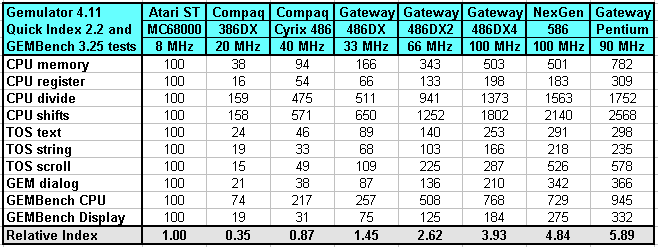
For PC Xformer, we did not have an existing benchmark utility to use. Such a thing did not exist on the Atari 8-bit computers since all Atari 8-bit computers used the exact same hardware running at the exact same 1.8 MHz. So instead, we used two of the sample Atari BASIC benchmarks that we've had up on this web page before: the simple FOR NEXT loop which loops 10,000 times, and the line sweep, which draws 320 lines across the screen in graphics mode 8. These benchmarks were also run on a real Atari 130XE and the times normalized so that the 130XE times have a relative speed of 1.0. The times shown are in seconds. The lower the number, the faster the benchmark ran.

The Cyrix 386-to-486 chip is amazing. At about $180 (cheaper today), this chip converts a slow 386 computer that barely runs Windows 95 to something comparable to a low end 486 and runs Windows quite well. In our test machine, a 20 MHz 386, the Cyrix chip improved performance by about 2 1/2 times. It went from being slow to respond to being quite responsive, even for such things as using the Windows 95 desktop. Considering that we only paid $200 for the computer (which is worth more than that for its memory alone), we were able to for under $400 put together a very nice little Windows 95 machine that also makes a good entry level Atari emulator.
The 486 results also surprised us. Our 66 MHz chip runs about 80% to 90% faster than the 33 MHz chip. Not bad, but not great. However, the 100 MHz DX4 chip did quite well. First, it only costs about $200. Second, it runs cooler than the 66 MHz chip. Partly due to the larger heat sink on it, and partly due to lower power consumption. The DX4 chip also has double the cache (16K instead of 8K) of the earlier 486 chips, allowing it to reference memory less often. Clearly this is a win, because in the PC Xformer benchmarks, the 100 MHz DX4 really does run at triple the speed of the 33 MHz chip, and almost triple the speed in the Gemulator benchmark. Overall, it performs at about 3/4 the speed of the 90 MHz Pentium, putting it in the speed class of a 66 MHz Pentium.
The NexGen 586 chip was a real disappointment. After reading all the literature about it and how this was a Pentium killer, the real world results proved otherwise. The 100 MHz 586 ran at about the speed of a 75 MHz Pentium, not at double the speed as the salesman wanted me to think. This chip is not only slower than a real Pentium, it isn't even a Pentium clone. The name "586" is a total marketing scam, intended to lead consumers into thinking that this is a Pentium clone. It is not. It sucks. Avoid the NexGen chip.
Summary: If you currently own a 386 computer, there is no need to throw it away. You can more than double your computer's speed with a simple Cyrix 486 upgrade chip. We do not recommend the NexGen 586 chip, nor do we recommend clock doubled 486 chips such as the 486DX2/50 or 486DX2/66. If you really need to run your Atari software at 5 or 10 times the speed of your original Atari, then by all means go out and buy that super fast Pentium system.
The screen shots below are actual results obtained by running Gemulator. These results are intended to show the approximate speed of execution of Gemulator on various PCs compared to the standard speed of either an ST (when 1.0 is highlited) or a TT (when TT is highlited). Since all PCs are slightly different "your milage may vary" as they say, so use these numbers only as a guideline.
Benchmarks were performed running Gemulator on either Windows 95 or Windows NT. Gemulator was set to run either TOS 2.06 with no screen acceleration, or MagiC 5.0 with NVDI 4.11. The DMA, GEMDOS, and RPM figures can be ignored since Windows disk caching makes those benchmarks unreliable.
Below each screen shot is the description of that particular setup and the elapsed stopwatch time of each benchmark. Lower stopwatch time is faster.
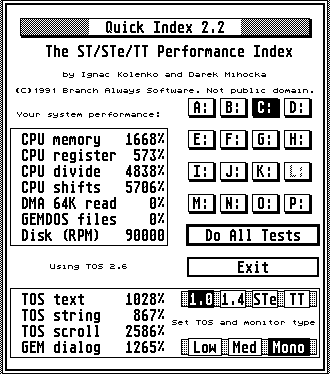
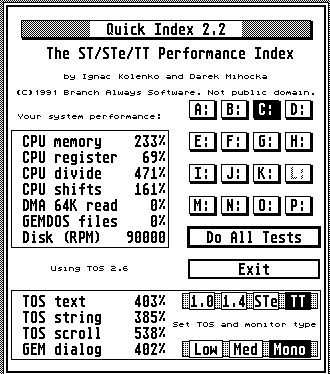
TOS 2.06, monochrome, Windows NT 4, 200 MHz Pentium Pro.
Elapsed stopwatch time: 4.3 seconds
(Left side shows speed relative to an ST, right side is relative to a TT)
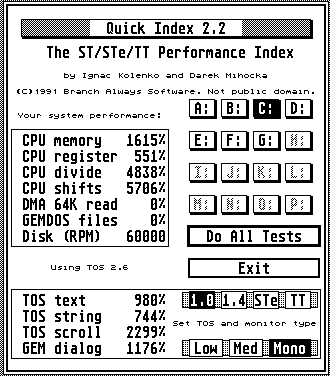
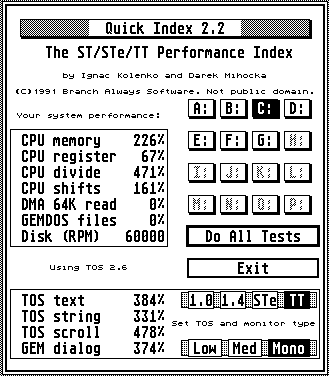
TOS 2.06, monochrome, Windows 3.11 with Win32s, 200 MHz Pentium Pro.
Elapsed stopwatch time: 4.8 seconds
(Left side shows speed relative to an ST, right side is relative to a TT)
Note: this is the same computer as above, except running Windows 3.11 instead of Windows NT 4.0. There is a slight speed loss when running on Windows 3.x.
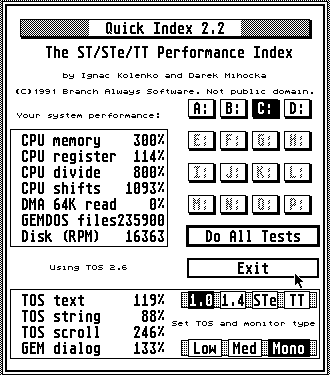
TOS 2.06, monochrome, Windows 95, 486DX2/50.
Elapsed stopwatch time: 37 seconds
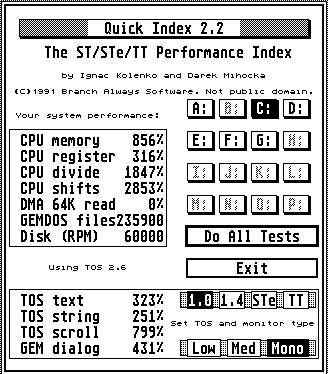
TOS 2.06, monochrome, Windows 95, 90 MHz Pentium.
Elapsed stopwatch time: 12.9 seconds
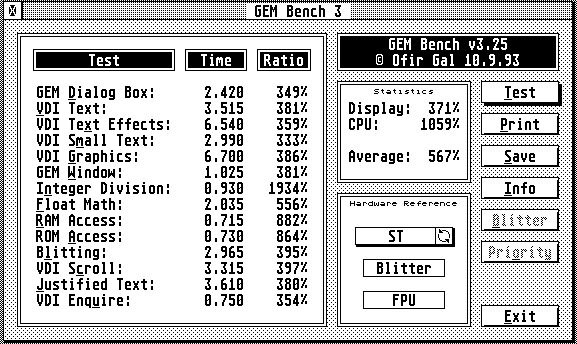
TOS 2.06, monochrome, Windows 95, 90 MHz Pentium.
Elapsed stopwatch time: 40.3 seconds
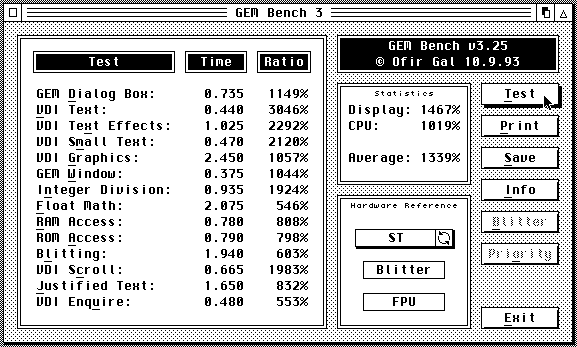
MagiC with NVDI 4.11, monochrome, Windows 95, 90 MHz Pentium.
Elapsed stopwatch time: 6.4 seconds
Apple, Mac OS, Macbook, Apple Silicon and Macintosh are registered trademarks of Apple Computer, Inc. Atari is a registered trademark of Atari U.S. Corporation. Athlon, Athlon XP, Opteron, Phenom, and Ryzen are registered trademarks of AMD. Arm is a registered trademark of Arm Limited. Microsoft, Windows, Windows NT, Windows XP, Windows Vista, Windows 7, Windows 8, Windows 10, Windows 11, Visual Studio, .NET, and/or other Microsoft products referenced herein are either trademarks or registered trademarks of Microsoft. Intel, Pentium, Core 2, Core i7, and Atom are registered trademarks of Intel. PowerPC is a trademark of IBM. Additional company and product names may be trademarks or registered trademarks of the individual companies and are respectfully acknowledged.